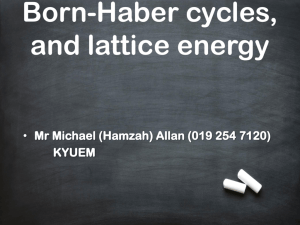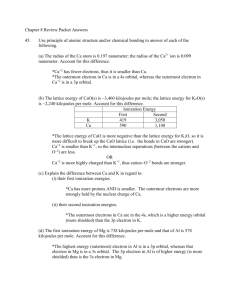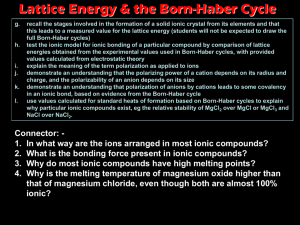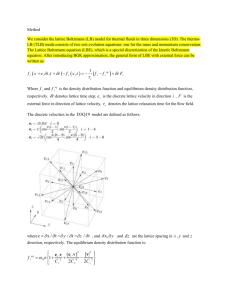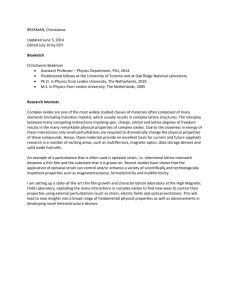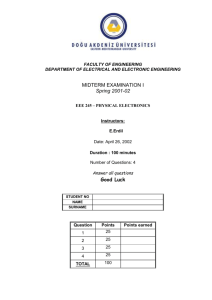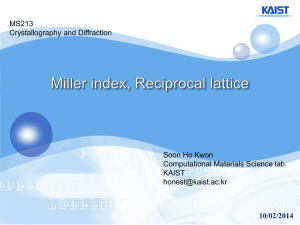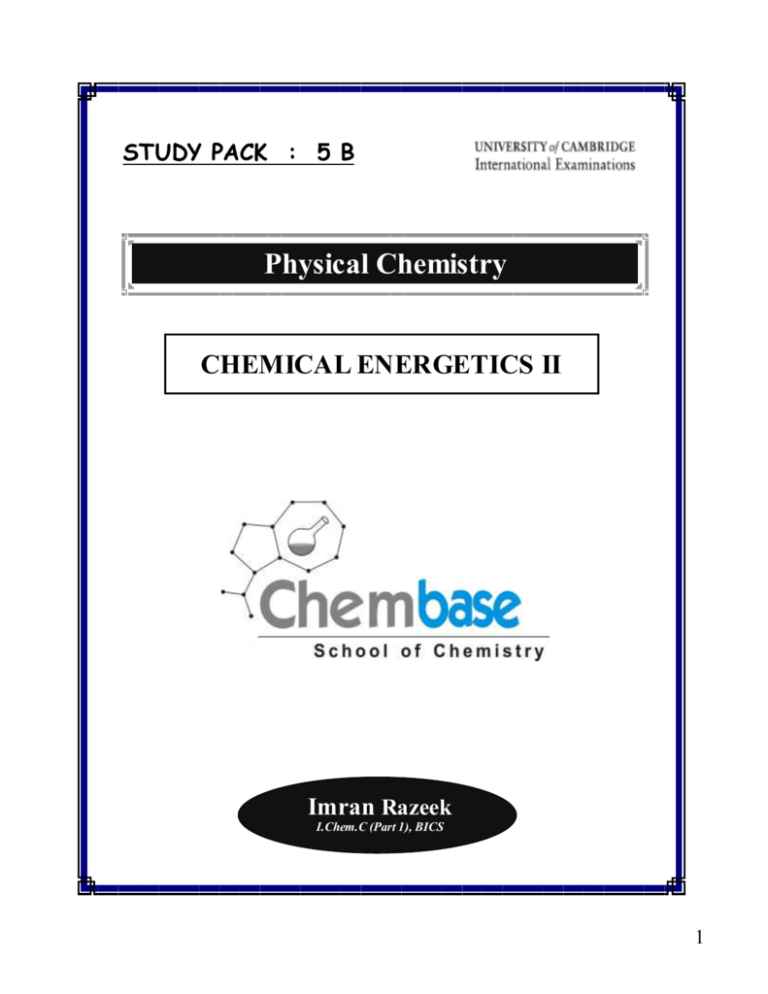
STUDY PACK : 5 B
1
-
-
-
-
2
1.
Define the following terms: a.
First ionization energy:The first ionization energy is the heat energy required to remove 1 mole of
electrons from a mole of gaseous atoms to form a mole of uni positive gaseous
ions.
M(g) – e
b.
M+(g)
∆ H(+ve)
Second ionization energy:The heat energy required removing 1 mole of electrons from a mole of uni
positive gaseous ion to form a mole of di positive gaseous ions.
M+(g) – e
c.
M+2(g)
∆ H(+ve)
First electron affinity:The energy released when 1 mole of gaseous atoms gains one mole of electrons
to form a mole of uni-negative gaseous atoms. Always exothermic.
d.
∆ H(-ve)
X- (g)
X(g) + e
Second electron affinity:The energy absorbed when 1 mole of uni negative gaseous ions gains 1 mole of
electrons to form 1 mole of di positive cations. always endothermic.
X-(g) + e
e.
Lattice enthalpy
∆ H(+ve)
X-2(g)
H latt
Lattice energy is the heat energy given out when one mole of an ionic solid is
formed from its gaseous ions. The enthalpy change is always exothermic.
Na+(g) + Cl- (g)
Mg2+(g) + 2Cl-
NaCl(s)
MgCl2(s)
3
a) State the factors that affect the value of the lattice energies
a. Sum of the ionic radii of the anion & cation.
b. Charges of the ions.
b) Explain how the size of the ion effect the lattice energy
The lattice energy depends on distance between nuclei of cation & anion. The lattice
energy is inversely proportional to the sum of the ionic radii.
When the sizes of the ions are smaller, the lattice energy will be larger.
E.g. LiF > LiCl > LiBr > LiF
c) Explain the effect of charge on the ion on lattice energies
Lattice energy is directly proportional to charge (L.E α charge). Therefore greater the
charge on the ions, larger the lattice energy.
E.g : Al2O3 > MgO > CaCl2 > NaCl
d) MgO solid has the same crystal structure as NaCl solid, the lattice enthalpy of NaCl is –771 kJ
mol-1 & that of MgO is –3889 kJ mol-1. Account for this difference.
2.
Describe the stages involved in the formation of a solid ionic crystal from its elements, hence
the calculation of lattice energy
atomization
Solid metal element
ionization
gaseous atoms
atomization
Non-metal element
electron affinity
gaseous element
gaseous metal cation
+
gaseous non metal anion
Solid ionic lattice
4
The Born-Haber cycle
3.
Explain what is Born-Haber cycle & its importance
The enthalpy cycle, which is used to determine the experimental lattice enthalpy of
a compound, is called the born-Haber cycle.
It is important because the experimental lattice energy of a compound cannot be
determined by a direct single step. Instead it is found by an indirect route based on
Hess’s law.
4.
Construct a Born-Haber cycle for Sodium Chloride, hence calculate the lattice enthalpy using
Hess’s law
Given that:
Standard enthalpy of atomization of Na
First ionization energy of Na
Standard enthalpy of atomization of Cl
First electron affinity of Cl
Standard enthalpy of formation of NaCl
+108.4 kJ mol-1
+500 kJ mol-1
+121 kJ mol-1
- 364 kJ mol-1
- 411 kJ mol-1
5
5.
Construct a Born-Haber cycle for MgCl2; hence use the data below to calculate the First electron
affinity of Chlorine.
Enthalpy Change
Atomization of Mg
First ionization energy of Mg
Second ionization energy of Mg
Formation of MgCl2
Atomization of Chlorine
Lattice enthalpy of MgCl2
kJ mol-1
+150
+736
+1450
-642
+121
-2493
6
6.
Construct a Born-Haber cycle for MgO.
7.
The equation for the heat of formation of Alumina is given as: 2Al(s) + 3/2O2(g)
Al2O3(s)
Enthalpy Change
Formation of Al2O3
Atomization of Al
First ionization energy of Al
Second ionization energy of Al
Third ionization energy of Al
Atomization of Oxygen
First electron affinity of Oxygen
Second electron affinity Oxygen
kJ mol-1
-1675.7
+324.3
+578
+1817
+2745
+249.2
-141.1
+790.8
7
8.
a) What does the values of lattice energies tells us? Thus what can we conclude from these values?
The grater (-)ve the value, the greater is the energetic stability of the lattice with
respect to it being broken up in to separation ions. Also the degree of ionic character can
be checked by the calculation.
8
b) Explain why the values of lattice energies calculated from Born-Haber cycle may differ from those
calculated from purely ionic model
A calculation based on purely ionic model assumes that crystal is made up of perfectly
spherical ions & when the geometry is determined from x-ray diffraction method. The
distance will between the ions will be known thus the lattice energy is calculated using an
equation.
But in the calculation of more co-valent & less ionic molecules (AgI). The equation gives a
lesser value than the born-Haber cycle because the molecule is more co-valent (highly
polarizable) therefore the lattice energy is less.
c) Explain why the experimental & theoretical lattice enthalpies differ?
The lattice enthalpy of a compound obtained using Born-Haber cycle is the actual
experimental lattice energy of a compound.
When the degree of co-valency of crystal greater the difference between experimental &
theoretical values will be grater. Such large difference occur when the cation has higher
polarizing power & the anion has high polarisability resulting more covalent character.
E.g.:
Experimental L.E
AgF
Ag Cl
Ag Br
Ag I
Imran Razeek
-943
-890
-877
-867
Theoretical L.E
-925
-833
-808
-774
The
difference
is greater as
the covalent
character
increases.
All Rights Reserved.
9

